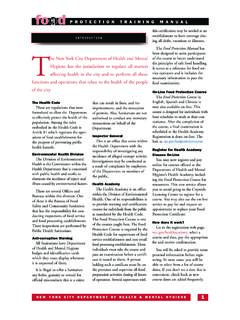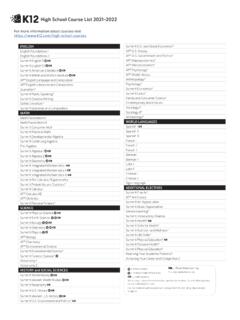Transcription of The Importance of Poultry In Our Lives
1 The Importance of Poultry In Our Lives Michael J. Darre, , Poultry have been on the earth for over 150 million years, dating back to the original wild jungle fowl Now we include ducks, geese, turkeys, pheasants, pigeons, peafowl, guinea fowl and chickens in the list of species under the general term Poultry . Poultry provide humans with companionship, food and fiber in the form of eggs, meat and feathers. Many people love to raise and show chickens and other Poultry species at fairs and other Poultry shows. Others just love to raise them for backyard pets and for fresh eggs every day. There is a large commercial chicken industry that provides us with eggs and meat.
2 The commercial egg laying industry is comprised of over 273 million laying hens, of which about 237 million produce table eggs (the eggs you buy at the supermarket) and the rest were for fertile hatching eggs as replacement for the laying flocks. In 1991 the United States produced about billion dozen eggs. Connecticut is a small state and has about million laying hens. The Poultry meat industry is comprised of the broiler and turkey industries. In 1991 there were billion broilers processed in the United States. This represents about billion pounds of ready-to-cook broiler meat. Per capita consumption of broiler meat was at about 70 lbs.
3 In 1991. Turkey productions was at about 276 million in 1991 which represents about billion pounds or about 18 lbs. Per person consumed. In Connecticut about 10,000 broilers and about 35,000 turkeys were raised in 1991. As can be seen, the Poultry industry is a large business. It generated in excess of 20 billion dollars in 1991, in the United States. It is worth an estimated 150 million dollars to Connecticut. Poultry breeding is where it all begins. Selected males and females of particular breeds are mated and the eggs collected and incubated. Chicken eggs are incubated for 21 days. The newly hatched chicks are brooded in temperature controlled rooms until they are either sent off as broilers or roasters for consumption as Poultry meat, or grown further as laying hens or breeders.
4 Birds grown for broilers are reared for 6 or 7 weeks and then are processed as cut-up parts, such as drumsticks, breast meat, wings, thighs, half chickens or quarter chickens. Roaster are grown for 8 to 14 weeks and are sold as whole birds for oven cooking, or for cut-up to be used in further processing. About 25 to 30% of broiler meat goes into further processed product, such as chicken nuggets, chicken sandwiches and chicken hot dogs. Chickens grown as laying hens are reared in growing houses until they are about 16 to 18 weeks of age and then they are moved into caged laying facilities. The birds start egg production at about 20 weeks of age and continue to lay until they are about 76 weeks of age.
5 Some birds are then molted and lay eggs for another six months or so and the rest are processed as fowl meat and are used for products like chicken soup. The interest in Poultry and Poultry products have grown tremendously in the last 20 years. Almost every country in the world has a Poultry industry of some kind. Japan is steadily increasing their domestic production of both broilers and egg producing birds. Countries of the former Soviet Union have always been producing Poultry and eggs and are continuing to increase their output to meet the new demand. China, the Middle East, and Africa are all areas where increasing demand for Poultry has resulted in significant increases in the number of chickens being reared for meat and eggs.
6 Because Poultry products are in demand around the world and because chickens and other Poultry can be reared in almost any part of the world, a renewed interest in Poultry projects for schools, 4-H groups and in the home has developed. One of the most popular projects for beginners is the Incubation and Embryology Project. Incubation and Embryology projects have been successfully managed in classrooms, as 4-H projects and by individuals all over the country. In Connecticut, Dr. Michael Darre, the Extension Poultry Specialist at the University of Connecticut, has a three-hour teacher- training course on how to conduct and manage the Incubation and Embryology project in the classroom, and how to incorporate the project into the total curriculum.
7 A teacher's guide is available for all interested. The project covers the basics of setting up and calibrating the still air incubator, setting and turning the eggs, hatching the chicks and brooding the chicks. Also included are instructions on preparing the IN-Vitro observation of the chick embryo, where a chick embryo is incubated outside of its shell so all the embryonic development can be observed from day 3 to about day 16 of incubation. Other Poultry projects include a chick brooding project, a laying hen project, a broiler growing projects and fitting and showing projects. Part of the basics of keeping and rearing Poultry is knowing some of the basic terminology associated with them.
8 A chick is any young chicken, up to about five or six weeks of age. A pullet is a young female chicken from hatch through the first year of age. A hen is a female chicken that has been laying for more than six months. A cockerel is a young male chicken and a cock or rooster is and adult, breeding male chicken. Some of the more popular breeds of chicken are the Single Comb White Leghorn, Sex-Link, Barred Plymouth Rock, Rhode Island Red and the New Hampshire Red. The White Leghorn breed lays white shelled eggs and is extensively used in commercial egg production throughout much of the United States. The Sex-Link is a brown egg layer and is found in New England, Southern California and scattered throughout the Southwest United States.
9 Much of Europe and other countries use different varieties of both the Leghorn and Sex-Links for egg production. For the backyard, non-commercial flocks, the Barred Plymouth Rock, Rhode Island Red and New Hampshire Red, among others, are the preferred bird. These are classified as dual purpose birds, because they can be used for both egg production and meat production. They are heavier than the Leghorn or Sex-Link and withstand variations in temperature better. For more information on where to purchase fertile eggs, chicks or young chickens, game birds, turkeys or water fowl, contact the Cooperative Extension System office nearest you, they are listed in the yellow pages, or contact Dr.
10 Michael J. Darre, Extension Poultry Specialist, U-40, 3636 Horsebarn Road Ext. University of Connecticut, Storrs, CT 06269-4040, (860)486-1008. Other Poultry equipment and supplies, as well as some show bird stock and other types of Poultry , can be purchased from the following companies1: Hall Brothers Hatchery Box 1026 Norwich, CT 06360 Phone: (860) 886-2421 FAX: (860) 889-6351 E-mail: (No website) Brower Products Highway 16 West Box 2000 Houghton, IA 52631 Phone: (319) 469-4141 FAX: (319) 469-4402 E-mail: Lyon Electric Company 1690 Brandywine Avenue Chula Vista, CA 91911 Phone: (619) 216-3400 FAX: (619) 216-3434 E-mail: McMurray Hatchery 191 Closz Drive Box 458 Webster City, IA 50595-0458 Phone: (800) 456-3280 FAX.




